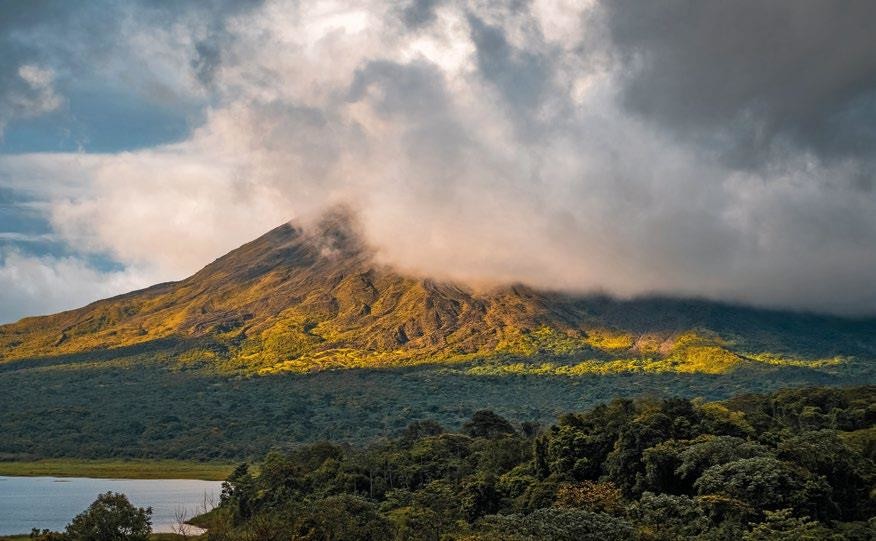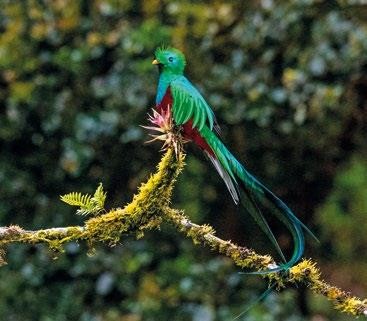Stepping off the grid is easy for travellers to this Central American country, where a life less structured, filled with untouched natural charm and surrounded by beauty comes, well, naturally. Charlene Fang spent a month embracing what Costa Ricans call living la pura vida – the pure life.


The beaches of Tamarindo are where the global surf community comes together in Costa Rica.
When you live in Costa Rica, you become accustomed to being surrounded by noise 24/7. The midnight howls of the neighbourhood dog. The sound of monkeys jumping from palm tree to palm tree. Loudspeakers blaring happy hour adverts in Spanish from the back of a pick-up truck. The cafe’s resident chipmunk shucking its daily nut above your head as you sip your morning coffee.
Strangely, none of these noises are agitating. Instead, they’re all part of Costa Rica’s charm and what makes it an ideal escape for today’s stressed, agitated individual – that is, someone like me.
Located at the cusp of Central and South America, a short three-hour flight from Florida, Costa Rica is very livable. It’s warm, with loads of beaches and natural attractions, and a big city (San Jose, its capital) equipped with all the necessary infrastructure to support a remote work scenario or a laid-back holiday for a month.
Our plan was simple. Find a place near the beach where we could live and work during the week, and rent a car on weekends to go exploring. A chance find on Airbnb, an industrial-style loft with a Balinese-style pool for US$1,000 (S$1,300) a month – just a five-minute Uber ride from the surf-friendly beach town of Jaco – sealed the deal.

Looking out over Manuel Antonio, the jewel of the Pacific Coast
Both a blessing and a “curse”, Costa Rica’s proximity to North America sees it heavily influenced by the United States. Popular towns like Jaco and Tamarindo feel uncomfortably familiar, with all the accoutrements (hip co-working places, third-wave coffee bars, surf and yoga schools) and the millennial jet set that populates other nomad hotspots like Barcelona, Lisbon and Cape Town – all of them attracted by a more affordable way of life but with a lot more lifestyle thrown in.
It’s not unusual to patronise shops owned by friendly Ticos (how Costa Ricans refer to themselves) but serviced by staff from all over the world. So, acclimatising is not an issue. It also helps that the locals have an easy-going nature as well as a family-friendly mindset, and are always eager to show visitors their favourite and lesser-known spots.
THE ESSENTIAL PURA VIDA EXPERIENCES
The real beauty of Costa Rica is in its natural setting. When one of the national mascots of a country is the sloth, its pace of life clearly trends towards leisure versus keeping busy.
For beach lovers, Costa Rica is paradise. It has no shortage of idyllic, picturesque settings, and depending on your location (and preference), there will be a suitable slip of sand and sea for you.
Popular spots include Manuel Antonio Beach, fringed by a rainforest and with a decent coral seascape for snorkelling. The pink-gold shores of Playa Conchal offer a chance to laze on fine white sand and admire seashells, while the burnt beige grains of Tamarindo let you get your surf on, and afterwards, assimilate right into the transient surf community that populates Costa Rica.
Wherever you choose to base yourself, a beach will be close by. And where there’s a beach, there will be surf instructors to help you fulfil any Step into Liquid dreams. At Jaco, a popular spot with Americans for a weekend jaunt, lessons by surf champs are dished out at rates starting from US$40 for two hours (inclusive of all equipment). They’ll get you surfing and cruising down to the shore like a pro, even if they have to push you right into the white water. For optimal lesson times, check the tides and schedule one either two hours before or after high tide.

Why not chase waterfalls while in Costa Rica?

Surf towns are at the heart of Costa Rica’s pleasing vibe.

While in Jaco, hitting the surf is mandatory.
THE BURNT BEIGE SANDS OF TAMARINDO LET YOU GET YOUR SURF ON, AND AFTERWARDS, GET RIGHT INTO THE TRANSIENT SURF COMMUNITY THAT POPULATES COSTA RICA.
Away from the beach, Costa Rica is one of the best places to embrace ecotourism. Everywhere you look, the locals do their best to lower their carbon footprint. They peddle art made from scrap metal, use glass instead of plastic in restaurants, and generally throw themselves into an active, nature-loving lifestyle. That is hardly surprising, as the plethora of national parks, volcanoes and rainforests means there’s always some aspect of nature to uncover. Unfortunately, that same abundance means that no matter how long a trip you have planned, you won’t be able to explore it all. One highlight would be the awe-inspiring cone-shaped Arenal Volcano – go hiking in the area to spot old lava trails and explore the different microclimates.
Equally impressive and photogenic is the fog-covered Monteverde Cloud Forest Reserve, home to the famous and elusive quetzal bird. It also has six different ecological zones offering rich biodiversity, with more than 400 bird, 100 mammal and 120 reptile and amphibian species.


Peer into Irazu Volcano to see a green crater lake that lies 300m deep.
If you only have time for one national park, though, Cahuita is a slice of Caribbean paradise and the epitome of what makes Costa Rica so special.
Located in Limon Province along the southern Caribbean coast, the 22,300ha marine area is a nesting ground for sea turtles and was created in 1970 to protect the surrounding coral reefs. Entry is free, but you can support its conservation efforts by hiring a guide (for US$55) to take you on a snorkeling tour, during which you may spot manta rays and sharks. Just diving into the cool, clear azure waters is pure bliss, and post-swim, you may come face-to-face with a monitor lizard lazily sunning itself on the sand – true story.
On the ground, the park is filled with mammal-spotting opportunities, as it is home to creatures such as northern tamanduas, sloths, playful howler monkeys, and the odd raccoon out to steal your snacks. It’s as grounding as an experience as you can get, one to make you appreciate that sometimes the best things in life are best left untouched and unplanned, just as nature decided. If that isn’t a gem of a vacation takeaway, we don’t know what is.

The quetzal is celebrated for its magnificent plumage.

Zip-line across Costa Rica’s tropical rainforests.
ICE, COCONUTS AND BEANS… LOTS OF BEANS
1. Copo (shaved ice)
Costa Rica’s blistering sun gives you a good excuse to indulge in anything icy and cold. Look for a copo vendor with his pushcart and order your shaved ice as you like – pick from powdered milk, cola syrup and condensed milk. If you’re lucky, he might have Dr Pepper syrup and other add-ons like fruit and marshmallows. For treats that are (arguably) healthier, every town has no shortage of ice-cream concoctions and fruit smoothie vendors. Look out for the Pops chain or any store with the word “heladeria” (ice-cream parlour) in its name. A scoop or fruit smoothie will set you back 700 colones (US$1.20).
2. Coconut juice
Look out for the man carrying a cooler box filled with ice-cold coconut juice (pipa fria) with a few slices of coconut meat, selling for 1,000 colones a serving. The trick to downing it like a local is to tear off the plastic from the bottom corner and drink it direct from the plastic bag – no fuss, no muss.
3. Bean-filled meals
At casual restaurants, order the traditional Costa Rican dish of casado, which includes a protein (pork, chicken or fish) with rice, beans, salad, tortillas and a fried plantain. Other popular dishes to try are the arroz con leche (rice mixed with milk), the sopra negra (black bean soup) and the chifrijo, which is an unbeatable combination of fried pork rinds and beans.

Costa Rica’s Version of Burning Man
Envision is the country’s version of the US festival, except that it takes place by the beach, and transactions involve money. Don’t let the commercial aspect dissuade you, though, from finding your higher vulnerable self at this four-day event. The next one will be held from Feb 20-23, 2020 (https://envisionfestival.com). Into its sixth year, the unique beach/ jungle setting (where toucans, howler monkeys and sloths live) attracts an eclectic mix of 5,000 attendees who are all there to soak up everything related to art, performance, dance, yoga and self-care. It culminates every evening on the beach in a sea of love and fellowship against the backdrop of a stunning pink-purple sunset.
COSTA RICA KNOW-HOW
How to Get There: We won’t lie: Getting to Costa Rica takes a while. Air France flies to Juan Santamaria International Airport via Paris from $2,300 for a round trip, and it’s a 30-plus hour flight.
Visas: Singaporeans don’t need a visa to travel to Costa Rica. While we are allowed to stay for 90 days, immigration officials have the right to decide how long you can remain, so if asked, do let them know your plans (what tours/excursions you’ve booked, and the places you intend to visit).
Proof of Travel: It’s not uncommon for proof of a return ticket or flight out of Costa Rica to be requested, so have it ready, along with the address of the place where you’ll be staying.
When to Visit: The wet (or green) season from May to mid-November is popular with tourists who want to explore the lush jungles and spots like Arenal Volcano National Park. The dry season from December to April is prime time for exploring the beaches and rainforests.
Cost: Costa Rica isn’t the cheapest country to visit in Central or South America. Expect to pay upwards of US$150-US$200 (S$206-S$274) a night for a hotel, with a meal at a casual restaurant costing US$8, and a night out (dinner and drinks) from US$50. All-inclusive tours are often priced from US$100, and entry to national parks like the Manuel Antonio one costs US$16.

Renting a Car: Unless you join a tour group, you’re unlikely to hit all the attractions. While companies like Costa Rica Shuttle and Interbus provide transfers between popular spots like Jaco, Tamarindo and Arenal, they can be costly. A better idea is to rent a car from Juan Santamaria International Airport for the duration of your trip (Adobe Rent A Car and Alamo Rent A Car are recommended providers). The daily rental isn’t expensive, but the insurance can add up to US$22 a day. The roads can be unpredictable, so make sure you sign up for full insurance, otherwise common scenarios like a flat tyre won’t be covered.
Public Transport: Buses connect most towns, but can be unpredictable. Taxis are common but more expensive than Uber, which only operates in larger towns like Jaco and San Jose. On the upside, Uber is inexpensive – a 5-10min ride can cost $2, whereas a one-way transfer between Jaco and Juan Santamaria International Airport costs from US$60, depending on the time of travel.
Where to Stay: Hotel chains (Best Western, Marriott, Westin), local hotels and eco lodges are all available. However, Airbnb offers the best variety, with rates from US$50 a night, depending on the season.
PHOTOS 123RF & UNSPLASH























